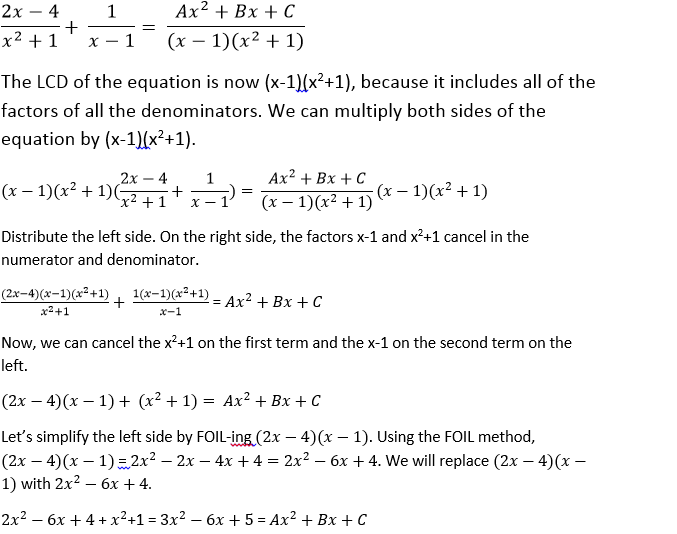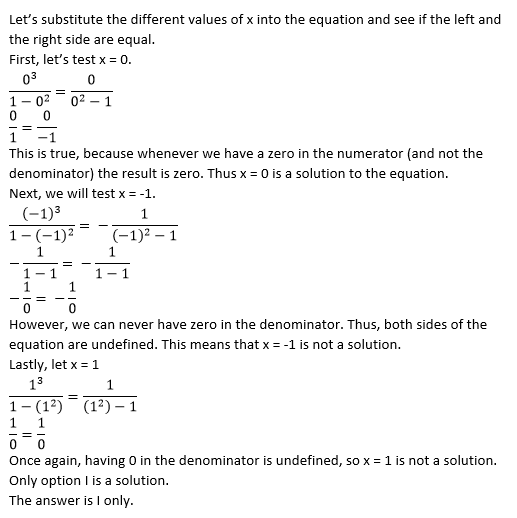Linear / Rational / Variable Equations - SAT Math
Card 0 of 960
Compare your answer with the correct one above
In the equation below,  ,
,  , and
, and  are non-zero numbers. What is the value of
are non-zero numbers. What is the value of  in terms of
in terms of  and
and  ?
?

In the equation below, 





Compare your answer with the correct one above
Compare your answer with the correct one above
Solve for x:

Solve for x:
The first step is to cancel out the denominator by multiplying both sides by 7:


Subtract 3 from both sides to get  by itself:
by itself:


The first step is to cancel out the denominator by multiplying both sides by 7:
Subtract 3 from both sides to get 
Compare your answer with the correct one above
Solve for  and
and  using elimination:
using elimination:


Solve for 

When using elimination, you need two factors to cancel out when the two equations are added together. We can get the  in the first equation to cancel out with the
in the first equation to cancel out with the  in the second equation by multiplying everything in the second equation by
in the second equation by multiplying everything in the second equation by  :
:


Now our two equations look like this:


The  can cancel with the
can cancel with the  , giving us:
, giving us:


These equations, when summed, give us:


Once we know the value for  , we can just plug it into one of our original equations to solve for the value of
, we can just plug it into one of our original equations to solve for the value of  :
:





When using elimination, you need two factors to cancel out when the two equations are added together. We can get the 


Now our two equations look like this:
The 

These equations, when summed, give us:
Once we know the value for 

Compare your answer with the correct one above
Give the solution set of the rational equation 
Give the solution set of the rational equation
Multiply both sides of the equation by the denominator  :
:


Rewrite both expression using the binomial square pattern:


This can be rewritten as a linear equation by subtracting  from both sides:
from both sides:


Solve as a linear equation:




Multiply both sides of the equation by the denominator 
Rewrite both expression using the binomial square pattern:
This can be rewritten as a linear equation by subtracting 
Solve as a linear equation:
Compare your answer with the correct one above
Solve:

Solve:

Multiply by  on each side
on each side

Subtract  on each side
on each side

Multiply by  on each side
on each side

Multiply by 
Subtract 
Multiply by 
Compare your answer with the correct one above
Compare your answer with the correct one above
Find the solution to the following equation if x = 3:
y = (4x2 - 2)/(9 - x2)
Find the solution to the following equation if x = 3:
y = (4x2 - 2)/(9 - x2)
Substituting 3 in for x, you will get 0 in the denominator of the fraction. It is not possible to have 0 be the denominator for a fraction so there is no possible solution to this equation.
Substituting 3 in for x, you will get 0 in the denominator of the fraction. It is not possible to have 0 be the denominator for a fraction so there is no possible solution to this equation.
Compare your answer with the correct one above

I. x = 0
II. x = –1
III. x = 1
I. x = 0
II. x = –1
III. x = 1
Compare your answer with the correct one above
A fraction is considered undefined when the denominator equals 0. Set the denominator equal to zero and solve for the variable.


A fraction is considered undefined when the denominator equals 0. Set the denominator equal to zero and solve for the variable.
Compare your answer with the correct one above
Solve:

Solve:
First, distribute, making sure to watch for negatives.


Combine like terms.

Subtract 7x from both sides.

Add 18 on both sides and be careful adding integers.

First, distribute, making sure to watch for negatives.
Combine like terms.
Subtract 7x from both sides.
Add 18 on both sides and be careful adding integers.
Compare your answer with the correct one above
Solve:

Solve:
First, distribute the  to the terms inside the parentheses.
to the terms inside the parentheses.


Add 6x to both sides.

This is false for any value of  . Thus, there is no solution.
. Thus, there is no solution.
First, distribute the 
Add 6x to both sides.
This is false for any value of 
Compare your answer with the correct one above
Solve  .
.
Solve 
By definition, the absolute value of an expression can never be less than 0. Therefore, there are no solutions to the above expression.
By definition, the absolute value of an expression can never be less than 0. Therefore, there are no solutions to the above expression.
Compare your answer with the correct one above
, 
In the above graphic, approximately determine the x values where the graph is neither increasing or decreasing.
, 
In the above graphic, approximately determine the x values where the graph is neither increasing or decreasing.
We need to find where the graph's slope is approximately zero. There is a straight line between the x values of  , and
, and  . The other x values have a slope. So our final answer is
. The other x values have a slope. So our final answer is  .
.
We need to find where the graph's slope is approximately zero. There is a straight line between the x values of 


Compare your answer with the correct one above
If 4_xs = v, v = ks , and sv ≠_ 0, which of the following is equal to k ?
If 4_xs = v, v = ks , and sv ≠_ 0, which of the following is equal to k ?
This question gives two equalities and one inequality. The inequality (sv ≠ 0) simply says that neither s nor v is 0. The two equalities tell us that 4_xs and ks are both equal to v, which means that 4_xs_ and ks must be equal to each other--that is, 4_xs_ = ks. Dividing both sides by s gives 4_x_ = k, which is our solution.
This question gives two equalities and one inequality. The inequality (sv ≠ 0) simply says that neither s nor v is 0. The two equalities tell us that 4_xs and ks are both equal to v, which means that 4_xs_ and ks must be equal to each other--that is, 4_xs_ = ks. Dividing both sides by s gives 4_x_ = k, which is our solution.
Compare your answer with the correct one above
Solve for z:
3(z + 4)3 – 7 = 17
Solve for z:
3(z + 4)3 – 7 = 17
1. Add 7 to both sides
3(z + 4)3 – 7 + 7= 17 + 7
3(z + 4)3 = 24
2. Divide both sides by 3
(z + 4)3 = 8
3. Take the cube root of both sides
z + 4 = 2
4. Subtract 4 from both sides
z = –2
1. Add 7 to both sides
3(z + 4)3 – 7 + 7= 17 + 7
3(z + 4)3 = 24
2. Divide both sides by 3
(z + 4)3 = 8
3. Take the cube root of both sides
z + 4 = 2
4. Subtract 4 from both sides
z = –2
Compare your answer with the correct one above
If 11 + 3_x_ is 29, what is 2_x_?
If 11 + 3_x_ is 29, what is 2_x_?
First, solve for x:
11 + 3_x_ = 29
29 – 11 = 3_x_
18 = 3_x_
x = 6
Then, solve for 2_x_:
2_x_ = 2 * 6 = 12
First, solve for x:
11 + 3_x_ = 29
29 – 11 = 3_x_
18 = 3_x_
x = 6
Then, solve for 2_x_:
2_x_ = 2 * 6 = 12
Compare your answer with the correct one above
If 2_x_ = 3_y_ = 6_z_ = 48, what is the value of x * y * z?
If 2_x_ = 3_y_ = 6_z_ = 48, what is the value of x * y * z?
Create 3 separate equations to solve for each variable separately.
-
2_x_ = 48
-
3_y_ = 48
-
6_z_ = 48
x = 24
y = 16
z = 8
x * y * z = 3072
Create 3 separate equations to solve for each variable separately.
-
2_x_ = 48
-
3_y_ = 48
-
6_z_ = 48
x = 24
y = 16
z = 8
x * y * z = 3072
Compare your answer with the correct one above
A sequence of numbers is: 2, 5, 8, 11. Assuming it follows the same pattern, what would be the value of the 20th number?
A sequence of numbers is: 2, 5, 8, 11. Assuming it follows the same pattern, what would be the value of the 20th number?
This goes up at a constant number between values, making it an arthmetic sequence. The first number is 2, with a difference of 3. Plugging this into the arithmetic equation you get An = 2 + 3 (n – 1). Plugging in 20 for n, you get a value of 59.
This goes up at a constant number between values, making it an arthmetic sequence. The first number is 2, with a difference of 3. Plugging this into the arithmetic equation you get An = 2 + 3 (n – 1). Plugging in 20 for n, you get a value of 59.
Compare your answer with the correct one above













